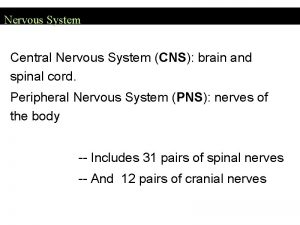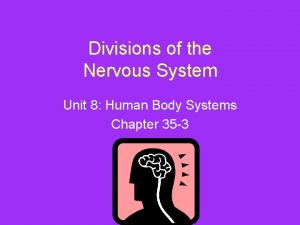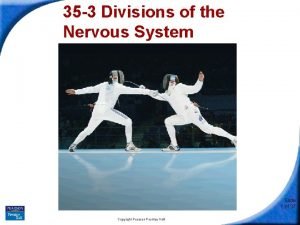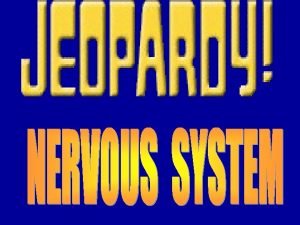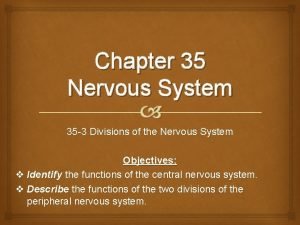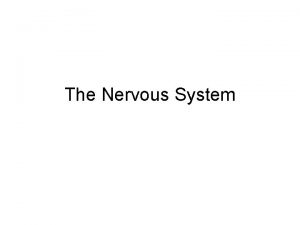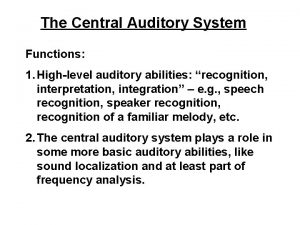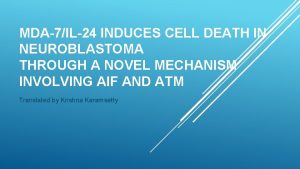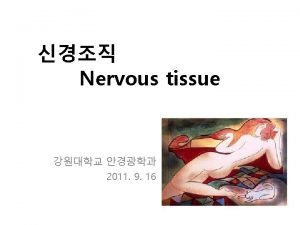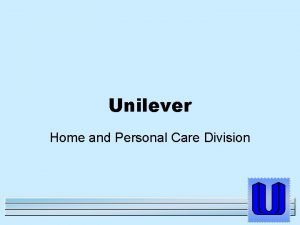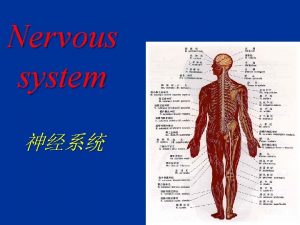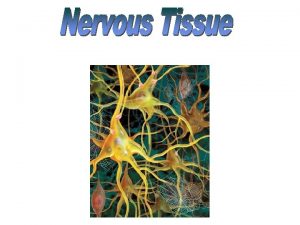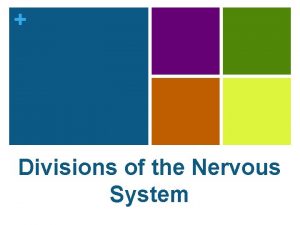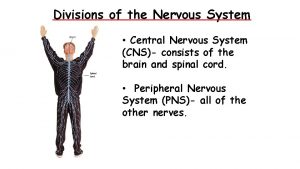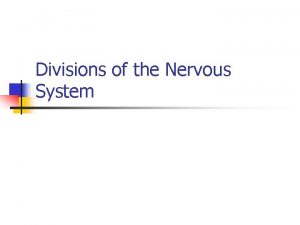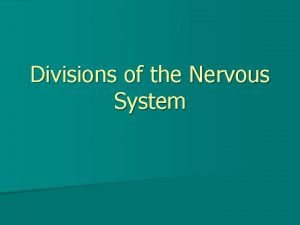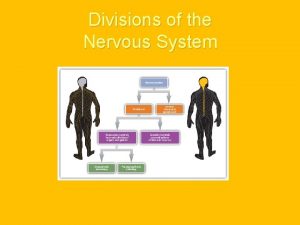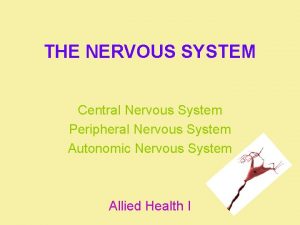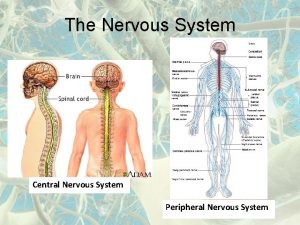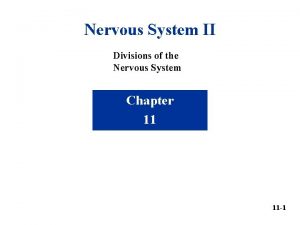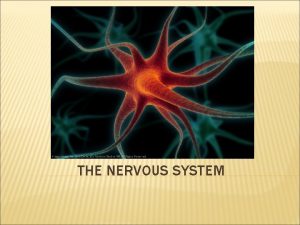NERVOUS SYSTEM NERVOUS SYSTEM 2 Main Divisions Central
























- Slides: 24

NERVOUS SYSTEM

NERVOUS SYSTEM 2 Main Divisions • Central NS – brain and spinal cord • Peripheral NS – all other nerves (cranial, spinal) CNS – median structure; all sensory impulses arrive there, all motor impulses begin there PNS -- nerves that lie outside (peripheral to) the CNS – convey all sensations and motor impulses to and from the CNS. -cranial nerves – originate from the brain and brainstem -spinal nerves – originate from the spinal cord • both give rise to smaller branches.


PERIPHERAL NS 2 Subdivisions Somatic System (voluntary) – sensory nerves from the skin and sensory organs (ear, eye, nose) and motor nerves to skeletal muscles Autonomic System (involuntary) – controls blood vessels, gland • further subdivided: Sympathetic – times of stress (injury, excitement, physical activity) Parasympathetic – conditions of normal organ functioning



NERVOUS TISSUE 2 Types of Nervous Tissue : Neuroglia – (glial cells) – 90% of the CNS -Small part of the PNS. -Provide structural framework for the neurons. -Non-conducting. • Neurons – Structural and functional unit of the N. S. even though they are outnumbered by glial cells - Perform the functions of the N. S. – sense changes, integrate information, make a motor response.


TYPES OF GLIAL CELLS -Astrocytes (CNS) – most numerous – form webs that surround capillaries, allowing small molecules (O 2 and CO 2) to pass through, keep others out. -Oligodendrocytes (oligodendroglia) (CNS) – help hold nerve fibers together – produce a myelin sheath, a protective covering -Microglia (CNS) – engulf and destroy microbes and debris in inflamed/damaged tissue -Ependymal (CNS) – line cavities of CNS – form and circulate CSF -Schwann cells (PNS) – form myelin sheath/neurolemma around peripheral nerves. Have high lipid content


NEURONS Classified according to the DIRECTION OF IMPULSE -Afferent (sensory) – toward brain and spinal cord -Efferent (motor) – toward muscles/glands/organs -Interneurons (AKA Association) – CNS only, connect afferent and efferent fibers



Classified according to STRUCTURE • -Multipolar – many dendrites, single axon (CNS to skel. muscle) • -Bipolar – single dendrite, single axon (special sensory areas) • -Unipolar – one fiber extending from the body, it splits into two branches (one to the spinal cord (axon); the other to the peripheral body (dendrite) (sensory from skin to sp. cord).



NEURON ANATOMY Cell body- has nucleus, cell membrane • At least 2 processes • Dendrites –receivers (impulses from other neurons – go to cell body) • Axon –senders (away from cell body) – 1 per neuron (may have branches, collaterals) • Nissl bodies – extra protein synthesis (Rough ER)


Myelin sheath – around axon (fat) insulation • – speeds up transmission (Schwann or oligodendroglia) • myelin – (white matter) inside – medulla • non-myelin (gray matter) outside – cortex Node of Ranvier- gaps in between that aid in impulse conduction Neurolemma – outer covering of axons [Schwann] • – helps in regenerating nerves • – none in brain and cord *no regeneration • Loses spindle fibers at about 3 yo – no longer able to mitotically divide





 Part of nervous system
Part of nervous system Label the parts of the main divisions of the nervous system
Label the parts of the main divisions of the nervous system 8 divisions of the nervous system
8 divisions of the nervous system Section 35-3 divisions of the nervous system
Section 35-3 divisions of the nervous system Divisions of the nervous system
Divisions of the nervous system Section 35-3 divisions of the nervous system
Section 35-3 divisions of the nervous system Nervous system divisions
Nervous system divisions Major divisions
Major divisions Main division of nervous system
Main division of nervous system Which neuron is rare
Which neuron is rare Sensory input and motor output
Sensory input and motor output Neuron processes
Neuron processes Central nervous system amusement park
Central nervous system amusement park Diagram of central nervous system
Diagram of central nervous system Nervous tissue
Nervous tissue Arthropod nervous system
Arthropod nervous system Bser aer
Bser aer Central nervous system for kids
Central nervous system for kids Central nervous sysytem
Central nervous sysytem Nervous system and digestive system
Nervous system and digestive system Endocrine system vs nervous system
Endocrine system vs nervous system Mechanism of hormone action
Mechanism of hormone action Endocrine system
Endocrine system Unilever 5 divisions
Unilever 5 divisions Respiratory tree divisions
Respiratory tree divisions

